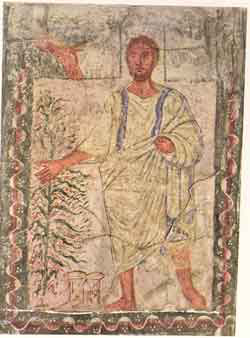Introduction
Miriam, the sister of Moses, appears in only four narrative scenes in the Torah: the saving of baby Moses (Exodus 2), the Song of the Sea (Exodus 15), the confrontation with Moses (Numbers 12) and her death (Numbers 20). In addition, her name alone appears in genealogical lists in Numbers 26 and I Chronicles 5. In Deuteronomy 24 her confrontation with Moses is cited as a warning regarding leprosy; and in Micha 6, she is named together with her brothers as a leader of the Exodus and Wanderings.
This paucity of reference to Miriam seems strange. Midrashic tradition loves her and connects her repeatedly with life-preserving water sources in the desert, even those that occurred after her death. Modern feminist critics and readers have continued this tradition in an attempt to rescue Miriam from near oblivion, instituting the custom of the Cup of Miriam.
In looking at works of art on Miriam, we find that the most popular scenes are the saving of Moses and the Song of the Sea. Very few treatments of the confrontation scene were created before modern times and no artistic renditions of Miriam’s death are to be found. We will examine the artistic and literary interpretations of each of these scenes chronologically, in order to see how attitudes toward Miriam have changed over time and in various cultural and religious contexts. As opposed to many other biblical personalities, there is no Muslim art on Miriam, possibly because of the conflation of Miriam the sister of Moses with Maryam, the mother of Jesus, evident already in the Quran.
The Rescue of Moses
We first meet Miriam in the rescue story of Moses. The persecution of the Israelites has led his mother to place her newborn child in a basket in the Nile, preferring to leave his fate to chance rather than to Pharaoh’s murderous henchmen. His sister watches from afar to see what will happen. When the baby is discovered by Pharaoh’s own daughter, the sister appears and offers to procure a Hebrew wet nurse and the baby is delivered miraculously to his own mother. Moses’ sister and mother (Miriam and Jochebed) are as yet unnamed in the biblical scene, as are all the other characters, who are mainly women.
The earliest extant painting of this scene, from the synagogue of Dura Europos, features Miriam and Jochebed as the Hebrew midwives, Shifra and Puah (Exodus 1:15).
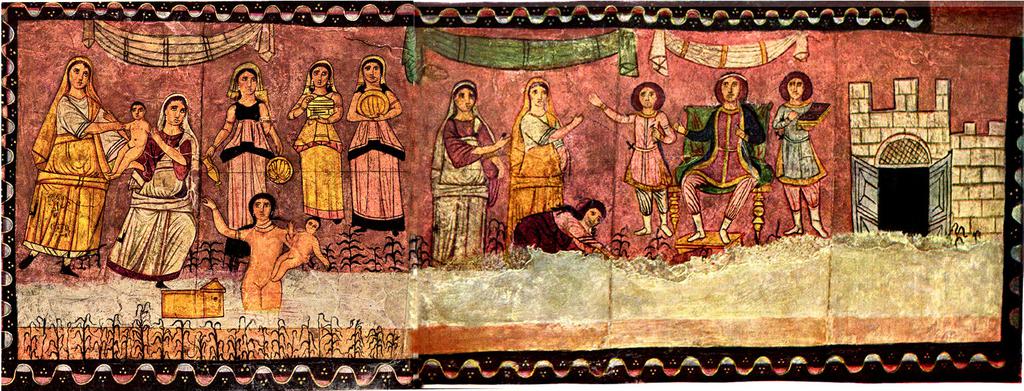
This identification is already found in the tannaitic midrash halacha, Sifre (Behaalotcha 20). Why does the midrash and why does the Dura artist adopt this identification? It seems possible that Miriam’s biblical role in the saving of Moses was seen as problematic, since it is minimal: she merely waits and watches and then steps in to reintroduce her mother into the story. But this act of grace has no apparent effect on the continuation of the story; after weaning Moses, Jochebed disappears and Moses grows up in the royal palace. We know nothing of his childhood or his national consciousness. But Miriam does restore the bond between mother and child, so emotionally satisfying to any audience. By identifying her as one of the midwives, she becomes even more significant – a veritable savior of Israel.
The next treatment of Moses’ rescue is from the Via Latina catacombs in Rome, dating from the 4th century.
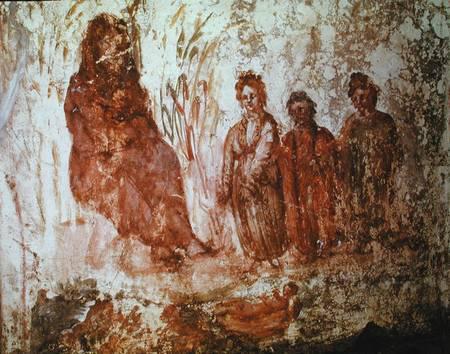
Most scholars identify the left figure of the trio as Pharaoh’s daughter, by her “crown”, her extended arm and her ladies-in-waiting. They identify the very large figure to the left as Miriam. However in comparing the iconography in much later renditions of the same scene,
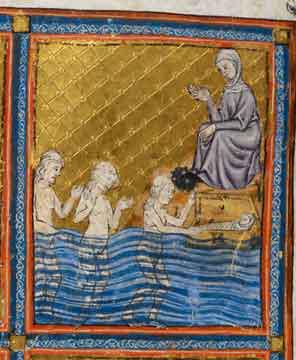
it appears to us that the large figure is Pharaoh’s daughter and the “crowned” figure is her personal servant or “amah”, who is sent to fetch the child. Thus, the catacomb painter cleverly combines both traditional Jewish understandings of “amah” in Exodus 2:5:
When she [Pharaoh’s daughter] saw the ark amongst the reeds,
“she sent her servant” or “she stretched out her arm” to take it.
The weakness of our argument is that there is a gap of a thousand years between the catacombs and the several 14th century haggadot that use this model. On the other hand the similarity of iconography is remarkable. The upshot of this analysis is that Miriam is not in the catacombs painting. This makes sense considering the Christian approach to Miriam we will see next.
The painting below is from an Italian bible moralisee of the 14th century, juxtaposing the biblical account and a Christological interpretation.
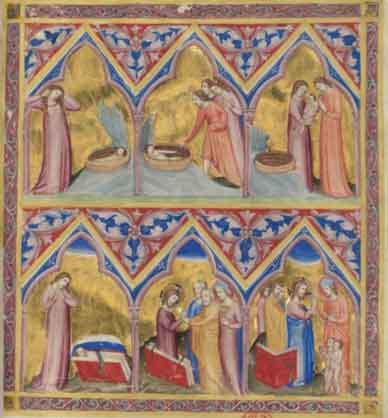
The captions above and below (not shown here) identify all the figures. Most important to us are the typological identifications of Miriam and pharaoh’s daughter. In the upper tier, Miriam stands at a distance concerned about the fate of the baby. In the next panel pharaoh’s daughter performs her saving role. In the lower tier, Miriam is identified as the Synagogue, which has abandoned Moses=Jesus. The daughter of Pharaoh is identified here as the Church, which has adopted him.
This typology goes back to the 2nd century church father, Origen, antedating the Catacombs. Since this commentary on the roles of Miriam and Pharaoh’s daughter was current at the time of the Catacombs painting, it seems possible that Miriam was not seen as a significant or inspirational part of the biblical scene, strengthening the identification of the large figure as Pharaoh’s daughter.
At approximately the same time, the so-called “Hispano-Moresque” haggadah has an entirely different interpretation of the rescue scene.
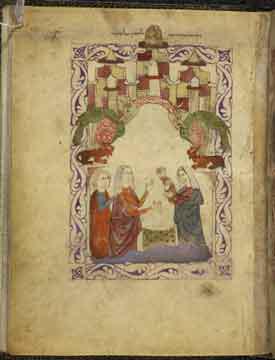
Here, we see a transfer of baby Moses, set within an elaborate frame, alluding to the prominence of animals in Egyptian religion. His sister Miriam and mother Jochebed receive the infant from Pharaoh’s daughter, to be nursed and cared for until his weaning. The Hebrew women stand opposite the Egyptian woman and they are separated by Moses’ ark, now on the shore above the Nile. Miriam is a bit shorter than Jochebed and her head is uncovered – indicating her youth. While Miriam stands on the periphery of the picture, her hand on Jochebed’s back is assertive – she is the agent, uniting mother and child.
Some two hundred years later, medieval manuscript painting has given way to the realism of Renaissance Europe.
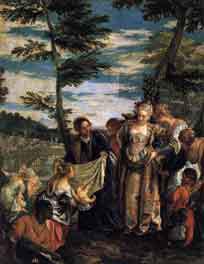
Veronese’s rendition of the familiar biblical scene luxuriates in a rich, colorful, courtly landscape. It’s the same baby that has been found, but there’s a whole crowd witnessing. Pharaoh’s blonde and bejeweled daughter is being advised by a finely dressed lady-in-waiting, while a dwarf, an African and several plainly dressed women surround them. It appears that Jochebed and Miriam are placed at the picture’s center: Jochebed is the older woman, dressed in blue and holding the baby’s swaddling; Miriam stands, once again, behind her, but simply looks on. This Miriam, although at the center of the action, is literally “behind the scenes”.
Johan Eduard Ihlee’s 19th century rendition of the scene is frankly kitsch.
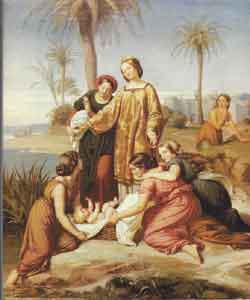
In a pseudo-Egyptian background, the beatific daughter of Pharaoh – alluding to the Virgin Mary – stands central, arms open to receive this new presence. The significant element in this picture is Miriam, standing close enough to assess what’s going on and to plan her next move. She is half-naked and dark, differentiating her from the refined Egyptian ladies and perhaps evoking a dusky Indian maid.
Portraying Miriam in this way seems incongruous, but may simply be the artist’s way of picturing “the other”.
The British Jewish painter Simeon Solomon chose a moment in the story not represented by any of the other artists: Jochebed and Miriam prepare to place Moses and the ark in the Nile in order to save him.
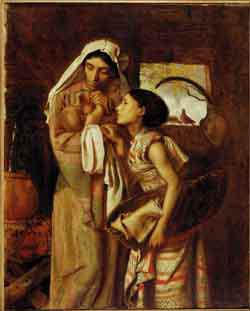
The text describes the baby as healthy and that they can no longer hide him from Pharaoh’s decree. The detailed composition of the basket, in which they will place him, seems to be a foil for the emotional state of the mother and sister, who pray for God’s grace. Solomon focuses on their love and anxiety.
Our final example on the finding of Moses is that of Marc Chagall.
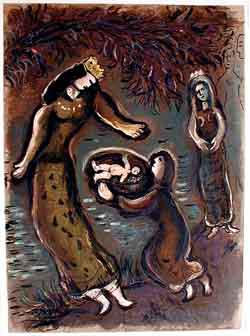
The interesting facet of this token painting is that two women are crowned here: naturally pharaoh’s daughter and curiously Miriam, “standing from afar to see what would become of him.” Once again, the varying understandings of “amah” are referenced by the awkward shape of pharaoh’s daughter’s left arm.
Thus Miriam, un-named in the biblical text, tends to appear in Jewish artwork and to be minimized in Christian artwork, in accordance with the readings of the story by these different religious groups.
The Song of the Sea and the Song of Miriam
The Song of the Sea in Exodus 15 celebrates the splitting and crossing of the Red Sea. There are actually two songs: the longer one (eighteen verses) is attributed to Moses
I will sing to the Lord, for He has triumphed gloriously;
Horse and driver He has hurled into the sea….
Only afterwards does a new (single verse) song begin:
20 Then Miriam the prophetess, Aaron’s sister, took a timbrel in
her hand,
and all the women went out after her in dance with timbrels.
21 And Miriam answered them:
Sing to the Lord, for He has triumphed gloriously;
Horse and driver He has hurled into the sea.
Only two verses, but they seem like a floating fragment and are certainly rife with problems.
• Miriam is named here for the first time and is called a prophetess. But neither here nor elsewhere does Miriam “prophesy” in any clear sense.
• Miriam is surprisingly titled the “sister of Aaron”. Why not the “sister of Moses”?
• Miriam is a leader here, at least of singing and at least of the Israelite women. If she is a leader, why does she appear so infrequently in the narrative?
• Verse 21 contains two strange formulations: the ambiguous word ותען and the masculine object להם. Since it is the women who follow her and they have not yet spoken, what and whom is she “answering”?
• Finally, Miriam seems to quote just a small section of Moses’ Song, but she changes the first word from “I will sing” to the imperative plural “Sing!”. What is the relationship between the two songs?
Regarding her titles “the prophetess, sister of Aaron”, Jewish midrashim ask and answer in a variety of ways why she is not called the “sister of Moses”? The general tendency is to refer to a prophecy by the young Miriam before Moses’ birth: she foretold Moses’ role as Israel’s savior, when she was as yet only Aaron’s sister. This also explains why she is called “prophetess”. However the explanation is entirely based on extra-biblical sources.
Some scholars see verse 21 as the title of the Song; the writer is simply saying that Miriam and the women sang the same song as Moses. Others see the two songs as representing two separate literary traditions (J and E). Many feminist writers suggest that the Song was originally Miriam’s, but was attributed later to Moses as part of a male-dominated agenda. A particularly impressive interpretation of the different wording (“I will sing” and “Sing!”), by T. Cohen, suggests that they represent two different types of leadership: Moses’ is frontal and dramatic, while Miriam’s is collaborative and earthy. Others see Miriam not only as a song leader, but as the prophetic leader of a women’s guild, similar to the “schools of prophets” mentioned in the Former Prophets. Support for this view is found in several biblical passages, where woman are the singers of victory songs (Judges 5, I Samuel 18:7)
Regarding ותען להם (“she answered them”), this curious phrase has been explained in various ways. Some say that she is addressing the entire community, both men and women. Others say she is responding to an angelic protest. Some say that the use of the third person feminine pronoun is inconsistent throughout the Tanakh. As for the word ותען, which usually means “she answered”, it can also mean “she addressed” or, according the NJPS translation, “she led”.
But the thorniest issue, since at least the middle ages, has been the appearance of Miriam and the Israelite women singing and dancing in the presence of the Israelite men. This would seem to contradict the rabbinic dictum, “A voice coming from a woman is nakedness” or “A woman’s voice is a sexual incitement (Soncino)”, on the basis of which women have been prevented from singing in public. In general, Jewish commentators concluded that the special circumstances of the miraculous event or the special character of Miriam enabled an abrogation of the general ban.
The artwork
How have artists seen Miriam in this episode? We will now present a selection of art on the Song of the Sea, arranged according to Miriam’s changing role vis a vis the Israelite community:
• Miriam (and other women) absent
• Miriam (and other women) within a mixed group
• Women and men separated
• Women performing for men
• Women only
Our earliest example of the crossing of the Red Sea – the 3rd century painting from the Dura Europos synagogue – excludes Miriam entirely, while Moses appears three times.

Dura-Europos, 243
In the 5th century mosaic of St. Maria Maggiore, and elsewhere, men and women, including Miriam and Moses, constitute a mixed group.
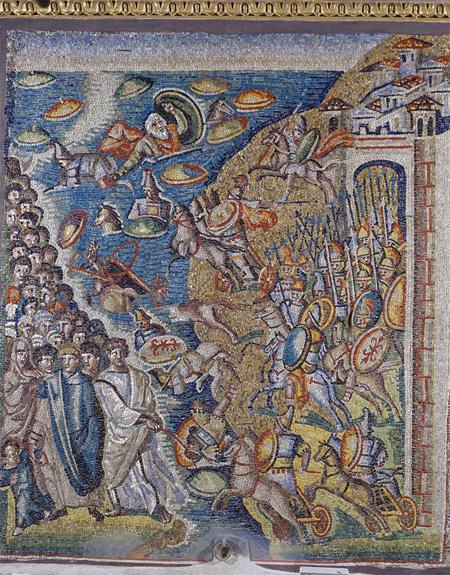
Santa Maria Maggiore, 432
Likewise in this 15th century illustration from Augustine’s City of God, there is a mixed group; but note that there is also a separate women’s chorus (toward the right).
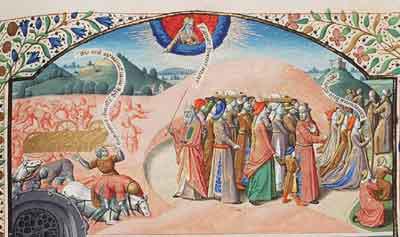
All face away from the Sea. Miriam is probably the first woman in the chorus; she plays a harp rather than a tambourine and she is, like the other women, kneeling rather than dancing.
In other cases, the scene contains separate groups of men and women, situated close to one another.
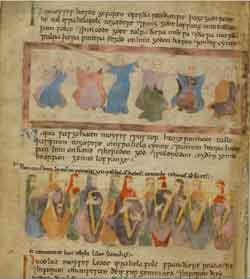
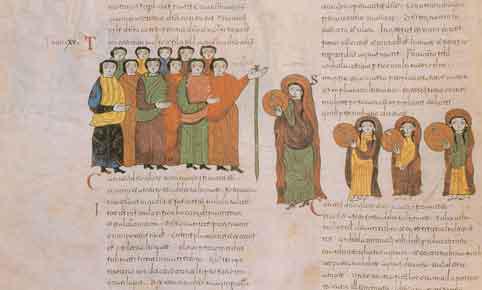
Visigothic-Mozarabic Bible of St. Isidore, 960
The two panels of the 12th century Aelfric paraphrase are surprising in their presentation. Below, married women (their heads covered) are standing in an orderly arrangement of instrumentalists. Logically Miriam is the central figure (with five players on either side), although she is not distinguished from the other women in any way. Dancing men, grouped around Moses with his staff fill the upper panel. The biblical text, of course, describes the women as the dancers. In 12th century England, it was apparently deemed inappropriate for women to dance in public, and so the biblical description was reversed. The emotional content of this painting is striking and freeing.
The scene in the 10th century Visigothic-Mozarabic Bible also shows two separate groups: the men are uniform figures (except for Moses with his staff), hands pointed to the right, faces frontal, feet in the same direction. The women too could be paper dolls holding tambourines. Again, all heads are covered. Only Miriam stands out, in her centrality and her size.
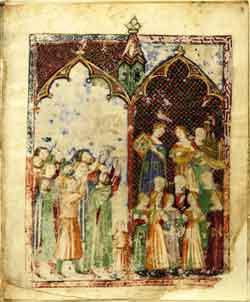
Two different types of movement characterize the 14th century Kaufmann haggadah. On the left, men raise their arms in vigorous praise. On the right, a group of young women dances sedately, accompanied by married singers (their heads covered). Behind them stand three musicians and the beautiful, young Miriam with her iconic tambourine. This triumphal event in Exodus 15 must have taken place outdoors. Not so in the Kaufmann haggadah, where women cannot be imagined dancing in public.
A very different approach is taken by artists who portray Miriam, alone or with the other women, openly performing for the male audience.

Leora Wise, And all the women.... Psalterion, Mt. Athos
9th century
The 9th century painting rom Mt. Athos represents the Greek tradition, which consistently portrays Miriam as an uninhibited, sensuous performer: her hair is loose, her arms are raised above her head playing castanets, her hips undulating under her flowing dress. The men clap in response to her dance and may even be participating. Moses, as always identified by his staff, stands behind the men, less involved.
Similarly, contemporary Israeli artist Leora Wise places Miriam within a group of female dancers and musicians, all dressed scantily, performing for a male audience, their identities hidden in the shadows.
Finally, we encounter paintings that portray only the women.

Second Nuremberg Haggadah, ca. 1450
For example, the 15th century Second Nuremberg Haggadah presents a group of married women, modestly dressed, dancing in the style of women at a Haredi wedding. Miriam plays the tambourine and another woman, a lute. We take note that Miriam faces away from the viewer, although her feet are making a different statement. Is this playful or intentional?
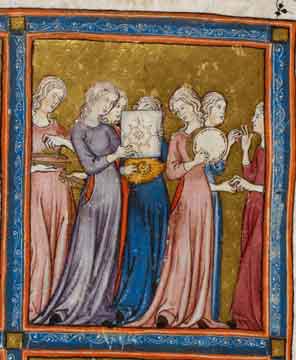
The fourteenth century Sephardi “Golden Haggadah” presents a truly joyous scene, outside of time and place: “spaceless space”. The large figures, all unmarried women, practically fill the entire canvas. There is a rhythm to the movement of the figures, the patterning of their dresses, their hands, their positions, etc. It’s as if the visual pattern reflects the sound pattern of the Song of the Sea. It is not absolutely clear which figure is Miriam, although it seems reasonable that she is one of the figures holding tambourines (one round and one square). The picture, then, is a celebration of women and not of a particular individual. There is no overt reference to the Song of the Sea, but rather it is a painting of a group of aristocratic young women, serenely singing and dancing. However here and in many other sephardi haggadot, Miriam’s Song is paired with pictures of the preparation for the Passover Seder. The statement is that Miriam’s act is the conceptual model for our own festivities.

This picture is from an Ethiopian manuscript of apocryphal material on Moses. The last illustration in the manuscript, it is the only one that deals with Miriam. But which figure is she? On the one hand, she may be the woman on the right, distinguished by her necklace and holding a rod, a sign of her leadership. All of the other women look toward her, while she looks back at them. On the other hand, she may be the central figure, holding a systrum, a type of clapper. In ancient Egypt, the systrum was associated with the cult of the fertility goddess Hathor. Perhaps it is this central figure which holds the rod. In other words, in either case Miriam is only identified by the objects she holds or wears.
Four moderns on Miriam
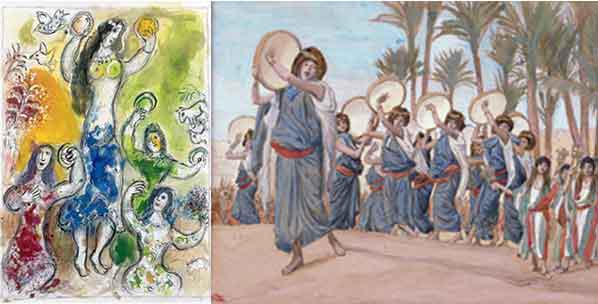
Tissot gives us two groups of women – adults on the left and girls on the right, both groups dressed in coordinated costumes. All are singing and dancing, as if on stage: the adults with hand drums and the girls with systra. The men, if present at all, are in an indistinct background.
Chagall’s women are clearly uninhibited: Miriam is topless, tall and central, her hair big and unbound. She leads the freeform dancing of the women. Chagall’s favorite flora and fauna embroider the edges – men, however, are absent. This is a women’s show.
Two other moderns present Miriam as a solo dancer
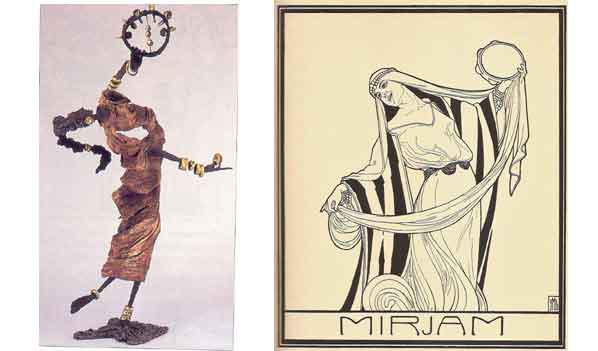
E. M. Lilien, unlike Chagall, pictures Miriam as a dignified, queenly figure, beautifully draped and bejeweled, dancing and singing. The folds of her garment are art nouveau, circles and rings emphasizing rhythmic movement. A recurring motif in Lilien’s work is the striped garment which gives Miriam an iconic status.
Phillip Ratner’s undulating Miriam is bent backwards, practically double. Her raised leg, long pony tail, bracelets and anklets accent her passionate movement. One hand holds the tambourine aloft. It becomes a focus of attention, because we expect to see Miriam’s head there. Her narrow skirt threatens to inhibit the movement of her exuberant body. She stands on a heap of fabric that might be her veil, abandoned in her ecstasy.
In sum, the moderns, like many of the traditionalists, tend to separate Miriam and the women from the men. But for entirely different reasons. Modesty is out of the picture; feminism is in.
Rebellion and leprosy
The next time we meet Miriam in the Torah narrative, she challenges Moses’ leadership (Numbers 12). At first she and Aaron bring up Moses’ marriage to a “Cushite woman” and afterwards they contest the exclusivity of Moses’ status as prophet. While Moses does not respond, God punishes the challenge by striking Miriam with leprosy. Moses and Aaron then intercede with God for Miriam’s healing. The matter of the Cushite woman has disappeared.
Aaron’s role in this story is ambiguous. While the first verb is feminine singular, making Miriam the instigator, the next verse attributes the challenge to both Aaron and Miriam. Yet, only Miriam is punished; why is Aaron not punished? Is this a reflection of an ancient struggle for status among rival Levitical groups? Is this also a gender issue, the first case of a woman vying for political or cultic status and a denial of the right of a woman to either?
There is no Jewish traditional art on Miriam’s rebellion. How should we understand this reticence?
In several Christian treatments of our story, as in the French Biblia Pauperum below, Miriam appears as the repentant sinner, parallel to David and Mary Magdalene.
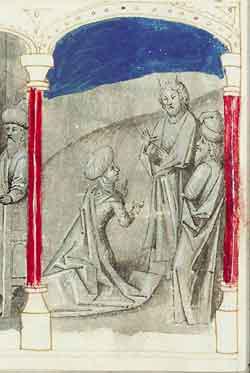
Miriam kneels, in a position of contrition (symbolizing her inferior status), while Moses and Aaron stand. Actually, in the biblical account, Miriam does not repent. Why then does the artist make her repentant? Could this be part of the parallel made in the Biblia Pauperum and by many Christian exegetes between Miram and Mary (Miriam) Magdalene, who only became the repentant prostitute centuries after the writing of the New Testament? It has been suggested that in both cases (Mary and Miriam) the underlying issue was a demotion of women as religious leaders.
Another artistic approach to our story is the view of Miriam as the unjustified challenger to Moses’ authority:

Here Miriam is portrayed as the “type” of the Synagogue. The accompanying text explains that Miriam defames Moses to Aaron, as “the Synagogue” and “the philosophers” defame the Church.
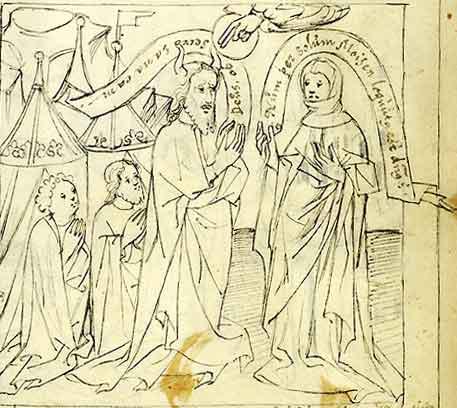
In this 15th century Biblia Pauperum, like the one above, Miriam is compared to David and Mary Magdalene. Here she is not repentant, nor is she struck with leprosy, but rather she stands assertively opposite Moses, while Aaron is missing.
The most interesting and perplexing rendition of our perplexing story is that of Martin Heemskerck, in a book of pictures on the eight Beatitudes. Each picture deals with one of the “blessed” in Jesus’ Sermon on the Mount, linking each of the eight characteristics cited with a figure from the Old or New Testament.
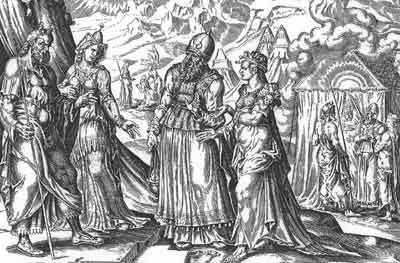
In this picture, Moses is the embodiment of the text of Matthew 5:5:
Blessed are the meek, for they shall inherit the earth
and the representative story is Miriam’s rebellion. Under the picture is an explanation of the parallel:
Happy is the gentle soul whose humility
crowned him as chief interpreter of the gods
He was imbued with the mind to rule the world
Moses was given thousands of divine words…
In other words, Moses’s humility (see Numbers 12:2) is what made him worthy of leadership.
On the left fringe of the picture, stand the horned Moses and the Cushite woman. He holds his emblematic rod; his posture and clothing are those of an unassuming shepherd. The Cushite woman is crowned and elaborately gowned. The two gesture defensively as if insulted. At the center of the picture, however, Miriam and Aaron stand facing Moses and the Cushite woman. Aaron wears his breastplate, a horned insignia on his mitre and carries a censer, all symbols of his priestly office. Miriam stands behind Aaron, wearing a tiara and a symbol of status. Their hands gesture, expressing the verse “Has the Lord spoken only through Moses? Has He not spoken through us as well?” In the background right, God reproves the rebels at the Tent of Meeting; in the left background, below, Aaron intercedes for Miriam, now stricken with leprosy and above, he succors her.
Two elements make this picture difficult to understand. On the one hand, while the picture is intended to highlight Moses’ humility, Aaron and Miriam are the most prominent figures, each one appearing four times, while Moses appears only three times. On the other hand, unlike all other artistic renditions of this story, the Cushite woman appears here; but her significance for the story is unclear.
Is it possible that Origen’s typological interpretation of Miriam as the synagogue and the Cushite woman as the gentiles who have been adopted by the Church, explains these questions? In the picture, Miriam and Aaron (the Pharisees and the Priests) disparage the Cushite woman (the gentiles) who Moses (the spiritual law, the Church) has married. Miriam is tried by God and punished with leprosy and banished from the camp (the congregation of believers), but will eventually be readmitted. Thus Moses’ humility is expressed in typological terms.
Miriam’s death and Miriam’s well
1 The Israelites arrived in a body at the wilderness of Zin on the
first new moon, and the people stayed at Kadesh. Miriam died
there and was buried there. 2The community was without
water…. Numbers 20
Abruptly, Miriam dies and is buried at Kadesh. No further details are given. The text then goes on without transition to recount yet another water crisis. Jewish tradition sought to understand the barrenness of the account and the juxtaposition of Miriam’s death with the new emergency.
The major conclusion of midrash was to connect Miriam with the rock that produced water for the people after Moses struck it. The connection is convoluted and varied:
- Miriam is connected with water throughout her life: saving Moses from the Nile, singing at the Red Sea, etc.
- It is by her virtue that the people of Israel are blessed throughout the years of wandering with a miraculous well that follows them through the desert
- When Miriam dies, the well stops flowing, in order that the people be reminded of her virtue and mourn for her
- Moses and Aaron are in mourning for Miriam and do not attend to the now dried up well
- Because of their thirst, the people once again turn on Moses, ignoring his bereavement
- God commands Moses to take his staff and attend to the water crisis
- The staff sometimes appears as a mark of Moses’ office and sometimes as an instrument of punishment
- Rashi refers to the fabulous well as follows:
- These words can be understood as meaning: 1) the well did not want to flow for Moses in order to give honor to Miriam or 2) Moses did not want to make the well flow for the people of Israel, because of Miriam’s death; while we prefer the first explanation, the second has the
- advantage of contextualizing the striking of the stone with
- Moses’ psychological state.
In light of this complex midrashic interpretation, it is strange that there are no pre-modern Jewish artistic treatments of Miriam’s death and the ensuing water crisis. However, several modern Jewish artists have dealt with this episode. We present here four works that, like the traditional midrashim, try to understand the diverse elements of Parashat hukkat, but are unable to fully clarify the connections between them.
Janet Shafner created two paintings dealing with Miriam’s final appearance in the Torah. In both she is connected with water, following the midrashim and in both Shafner refers to the Red Heifer purification rite that precedes the account of Miriam’s death. In one of her painting she also includes the copper serpent, which appears at the end of the parashah. The common element is healing: the copper serpent in the center heals Israel, the ashes of the red heifer purify contamination of Israel and Miriam’s devotion “heals” Israel’s thirst. Visually, Shafner uses triangles and colors to organize the various elements: red for the fire of the red heifer, blue for the water of Miriam’s well and purple (the combination of red and blue) for the copper serpent.
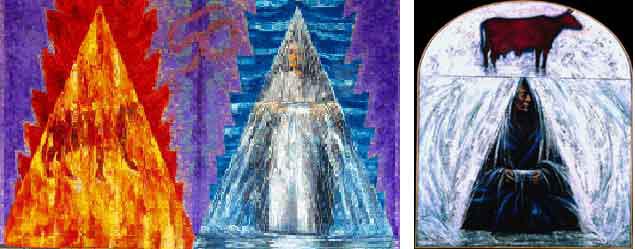
J. Shafner,
Parashat Hukat, 2007 Miriam, 1997
Siona Benjamin has also treated Miriam a number of times and sees her as a tragic figure. In the painting below, Benjamin has placed Miriam in the ritual setting of the Passover seder.
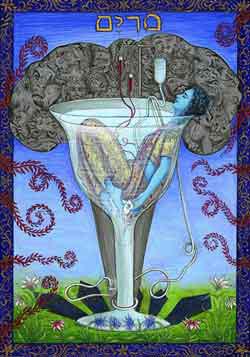
An innovation of the 20th century, Miriam’s cup is a parallel to Elijah’s wine cup of wrath. But her cup contains life-giving water as appropriate to Miriam’s role in midrash. Here she is connected to two IV’s: blood and water. Behind her, there is a “mushroom cloud”, containing grotesque faces. Her hand holds a switch to call for help.
In Archie Rand’s treatment of the weekly Torah portion Hukkat, six elements fill his canvas: two tents on the left, Moses and a rocky formation on the right, a stone structure for fire/water in the center and the copper serpent in the foreground at left. The subject of the portion is purification from contact with the dead. This is accomplished through the ashes of a Red Heifer. The tents, pocked with disease, will be purified with water mixed with these ashes.
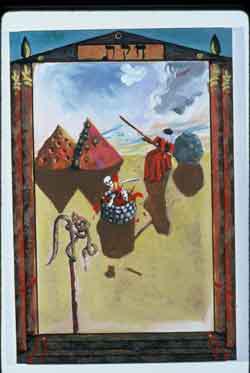
A. Rand, Parashat Hukat, 1989
The stone structure in the center appears to be a burning fireplace. Body parts nearby might be the remains of an unidentified and abandoned corpse that could cause contamination. Enigmatically, this structure also looks like a well.
To the right, a veiled figure holds the emblamatic staff. Is this Moses or is it the ghostly Miriam in a beautiful, pleated dress? In the continuation of the parasha, Moses strikes the rock with his staff and water gushes out to pacify the thirsty Israelites. In midrash, however, this is again Miriam’s well, described as pocked with holes. Rand has combined the two views and perhaps given Miriam an almost regal presence.
Finally, the copper serpent, built by Moses to magically heal those bitten by a sudden attack of seraphim or winged serpents, stands closest to the viewer. The portion deals with the mystery and fears surrounding death. Rand has made reference to many elements of the portion; Miriam, if referenced at all, is obscured.
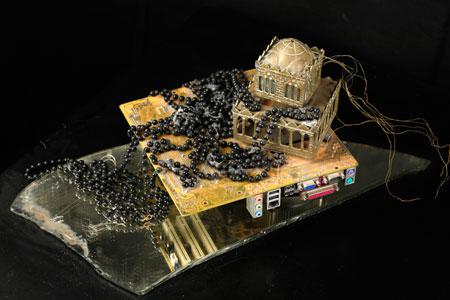
Jo Milgrom, The well of Miriam
With her death, Miriam's well goes dry. The bubbles have become precious black jewels.
This final episode in the life of Miriam is a kind of a metaphor for her life and character. The hidden is greater than the revealed: “there’s more to it than meets the eye”.
For additional images on this subject see TALI Visual Midrash



